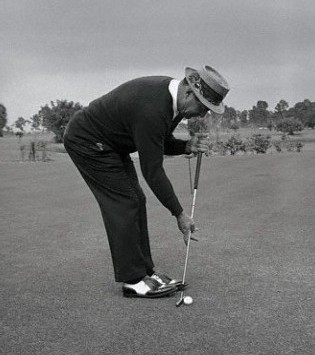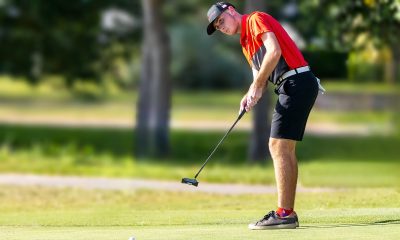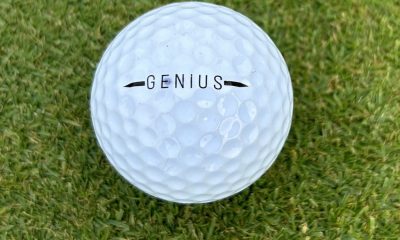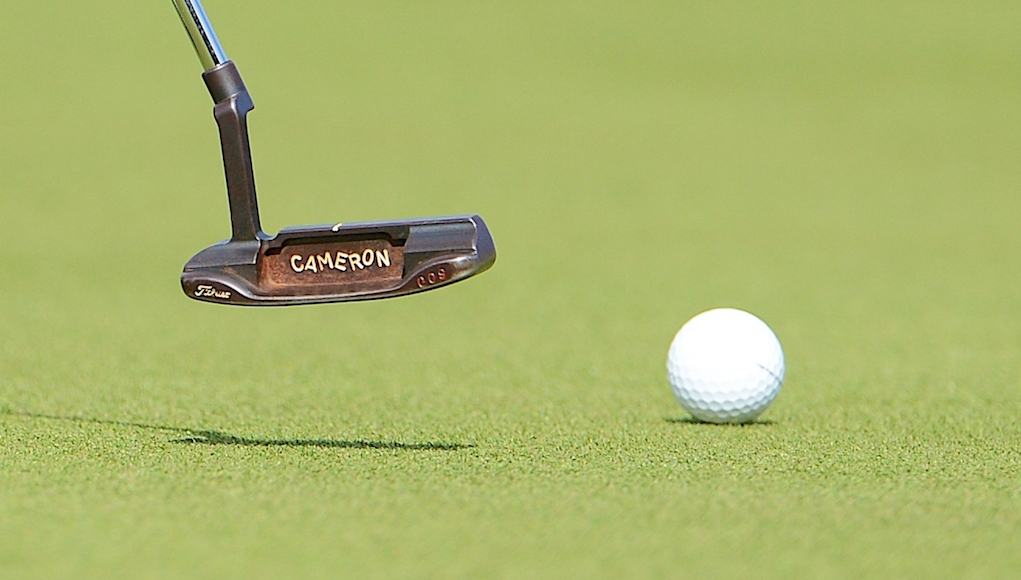Instruction
Pulled In A New Direction? How To Putt Sidesaddle

Now that the shoe has dropped and the two major governing bodies of golf have announced a plan to ban anchoring in the golf swing, a fair number of golfers and golf fans are left to ask myriad questions, such as “why now?” and “what options do I have?” Enough writers have taken pains to clarify that the anchor point is banned, not the long putter shaft. Hopefully word gets out and assuages the multitude of torn souls whose salvation was heisted. After enough stages of grief have passed, perhaps these former dilettantes of dwarf will consider life beyond the anchor. For them, and as a fellow sufferer, I offer this piece of solace through the maelstrom.
Face The Music
If you saw the golf movie Seven Days In Utopia, based on the book of the same name by David Cook, you know that the protagonist (spoiler alert!) adopted face-on putting to prompt a return to the professional golfing circuit. The question how would you toss a golf ball to the hole is anything but a zen koan; the answer is simple. You would not stand sideways to the hole and toss it under your lead shoulder, as you essentially do with a traditional putting stroke. Instead, just as you shoot a basket, you would square your shoulders to the target and toss the ball underhanded. You would probably come pretty close to the hole, too. Recent history has veiled the identity of the individual who developed face-on putting, but Gary McCord has written about it in golf magazines and Randy Haag (a northern California amateur) has parlayed its use into regional victories and national amateur success at the mid-amateur level. Even PGA Tour player K.J. Choi gave it a try in 2010 in the British Open!
After Sam Snead’s croquet style was ruled non-complying by the USGA in the late 1960s, Snead went to sidesaddle putting. In those days, the longer putter shaft was nearly non-existent, so Snead went to work with a traditional-length putter. He putted well, winning four West Virginia Open championships and three PGA Senior championships with the method. Randy Haag is a champion amateur golfer from northern California and has been putting face-on for more than 16 years. For a look at his competitive record, visit http://randyhaag.com/about/ and locate any wins and honors from 1997 on. Credit those to the switch.
With face-on putting, I suggest that you find a lengthened putter. It might be the belly one that you imagined you’d use to stake your garden, or it might be one a bit longer. Be certain that you don’t anchor your upper hand to your shoulder (remember the ban?), but that you instead find a way to stabilize the upper hand (the fulcrum) below where the club shaft and head swing. If you are a right-handed putter, position your right foot slightly ahead of the left and then work on horizontal and vertical ball position. Horizontal spacing measures how far “out” from your right foot the ball rests, while vertical spacing determines whether the ball is behind, ahead of or even with the tip of your right shoe. Finally, start practicing.
After working for all of three or four sessions on the aforementioned personal putting green, I played 27 holes at a course between Buffalo and Rochester in early December. I was stunned to find the greens stimping at 9 or 10, simulating in-season conditions. To my partner’s amazement, I did not miss a putt inside 10 feet all day. I’ll admit that I didn’t have any long putts with enormous break (the next hurdle), but I did find my long-distance pace rather quickly. One or two of the 50-feet plus putts were pushed a foot or two off line, but the distance was excellent, leaving me with no more than 2-3 feet for the comebacker.
Here’s my check list for a successful side-saddle safari:
- Find a putter length with which you feel comfortable. I prefer longer shaft, as I don’t want to bend over and strain my lower back.
- Find a putter head that minimizes off-center hit penalties. I changed from an Anser-style head to a Two-Ball mallet for that reason.
- Determine if you want to putt with your left or right foot forward, or have both feet even.
- Determine where to situate the ball, both vertically and laterally. There are many options here, just as with a regular stance: ball forward, even with toes or behind toes. Ball tight against foot or farther away.
- Practice, Practice, Practice. One of the reasons Ernie Els indicated he putted so well with the belly putter was the need for practice. He had putted traditionally for so long that he got lazy and stopped grinding. With the belly putter, there was always enough light at the end of the tunnel that he kept working and kept improving, all the way to a British Open title.
- Putt for something. Find great putters and putt against them for sodas or change or golf balls (or big stakes, if you like). You need to simulate the same pressure you’ll feel on the golf course.
Conclusion
I’ve always been a streaky putter and have often told new partners in May, in the midst of taking 40 putts in a round, that I’ll be down to 28 or 30 in a month and that they will be stunned to find me putting so well. I’m quite interested in taking face-on putting to two levels in 2013. I will begin the season with it, then plan to use it in regional qualifiers for New York State and Buffalo District amateur events. My opinion is that friends will give me good-natured grief for using the method. They will be less inclined to continue the banter when I continue to putt lights out. I expect the reaction in the heat of competition to be much less cordial. Assuming that I am able to control my emotions and execute, I anticipate utterances of:
That can’t be legal
Some guys will have no shame and
If I putted like that…
Truthfully, none of that will matter. If I want to get the ball in the hole and shoot the best score I can, and if sidesaddle or face-on or whatever you call it gives me that opportunity, so be it. If they say That’s not a golf swing. I’ll ask them, “Was Kareem Abdul-Jabbar’s sky hook a set shot?” That should quiet the masses. Check back here at GolfWRX.com and learn of my progress.
Instruction
The Wedge Guy: Beating the yips into submission

There may be no more painful affliction in golf than the “yips” – those uncontrollable and maddening little nervous twitches that prevent you from making a decent stroke on short putts. If you’ve never had them, consider yourself very fortunate (or possibly just very young). But I can assure you that when your most treacherous and feared golf shot is not the 195 yard approach over water with a quartering headwind…not the extra tight fairway with water left and sand right…not the soft bunker shot to a downhill pin with water on the other side…No, when your most feared shot is the remaining 2- 4-foot putt after hitting a great approach, recovery or lag putt, it makes the game almost painful.
And I’ve been fighting the yips (again) for a while now. It’s a recurring nightmare that has haunted me most of my adult life. I even had the yips when I was in my 20s, but I’ve beat them into submission off and on most of my adult life. But just recently, that nasty virus came to life once again. My lag putting has been very good, but when I get over one of those “you should make this” length putts, the entire nervous system seems to go haywire. I make great practice strokes, and then the most pitiful short-stroke or jab at the ball you can imagine. Sheesh.
But I’m a traditionalist, and do not look toward the long putter, belly putter, cross-hand, claw or other variation as the solution. My approach is to beat those damn yips into submission some other way. Here’s what I’m doing that is working pretty well, and I offer it to all of you who might have a similar affliction on the greens.
When you are over a short putt, forget the practice strokes…you want your natural eye-hand coordination to be unhindered by mechanics. Address your putt and take a good look at the hole, and back to the putter to ensure good alignment. Lighten your right hand grip on the putter and make sure that only the fingertips are in contact with the grip, to prevent you from getting to tight.
Then, take a long, long look at the hole to fill your entire mind and senses with the target. When you bring your head/eyes back to the ball, try to make a smooth, immediate move right into your backstroke — not even a second pause — and then let your hands and putter track right back together right back to where you were looking — the HOLE! Seeing the putter make contact with the ball, preferably even the forward edge of the ball – the side near the hole.
For me, this is working, but I am asking all of you to chime in with your own “home remedies” for the most aggravating and senseless of all golf maladies. It never hurts to have more to fall back on!
Instruction
Looking for a good golf instructor? Use this checklist

Over the last couple of decades, golf has become much more science-based. We measure swing speed, smash factor, angle of attack, strokes gained, and many other metrics that can really help golfers improve. But I often wonder if the advancement of golf’s “hard” sciences comes at the expense of the “soft” sciences.
Take, for example, golf instruction. Good golf instruction requires understanding swing mechanics and ball flight. But let’s take that as a given for PGA instructors. The other factors that make an instructor effective can be evaluated by social science, rather than launch monitors.
If you are a recreational golfer looking for a golf instructor, here are my top three points to consider.
1. Cultural mindset
What is “cultural mindset? To social scientists, it means whether a culture of genius or a culture of learning exists. In a golf instruction context, that may mean whether the teacher communicates a message that golf ability is something innate (you either have it or you don’t), or whether golf ability is something that can be learned. You want the latter!
It may sound obvious to suggest that you find a golf instructor who thinks you can improve, but my research suggests that it isn’t a given. In a large sample study of golf instructors, I found that when it came to recreational golfers, there was a wide range of belief systems. Some instructors strongly believed recreational golfers could improve through lessons. while others strongly believed they could not. And those beliefs manifested in the instructor’s feedback given to a student and the culture created for players.
2. Coping and self-modeling can beat role-modeling
Swing analysis technology is often preloaded with swings of PGA and LPGA Tour players. The swings of elite players are intended to be used for comparative purposes with golfers taking lessons. What social science tells us is that for novice and non-expert golfers, comparing swings to tour professionals can have the opposite effect of that intended. If you fit into the novice or non-expert category of golfer, you will learn more and be more motivated to change if you see yourself making a ‘better’ swing (self-modeling) or seeing your swing compared to a similar other (a coping model). Stay away from instructors who want to compare your swing with that of a tour player.
3. Learning theory basics
It is not a sexy selling point, but learning is a process, and that process is incremental – particularly for recreational adult players. Social science helps us understand this element of golf instruction. A good instructor will take learning slowly. He or she will give you just about enough information that challenges you, but is still manageable. The artful instructor will take time to decide what that one or two learning points are before jumping in to make full-scale swing changes. If the instructor moves too fast, you will probably leave the lesson with an arm’s length of swing thoughts and not really know which to focus on.
As an instructor, I develop a priority list of changes I want to make in a player’s technique. We then patiently and gradually work through that list. Beware of instructors who give you more than you can chew.
So if you are in the market for golf instruction, I encourage you to look beyond the X’s and O’s to find the right match!
Instruction
What Lottie Woad’s stunning debut win teaches every golfer

Most pros take months, even years, to win their first tournament. Lottie Woad needed exactly four days.
The 21-year-old from Surrey shot 21-under 267 at Dundonald Links to win the ISPS Handa Women’s Scottish Open by three shots — in her very first event as a professional. She’s only the third player in LPGA history to accomplish this feat, joining Rose Zhang (2023) and Beverly Hanson (1951).
But here’s what caught my attention as a coach: Woad didn’t win through miraculous putting or bombing 300-yard drives. She won through relentless precision and unshakeable composure. After watching her performance unfold, I’m convinced every golfer — from weekend warriors to scratch players — can steal pages from her playbook.
Precision Beats Power (And It’s Not Even Close)
Forget the driving contests. Woad proved that finding greens matters more than finding distance.
What Woad did:
• Hit it straight, hit it solid, give yourself chances
• Aimed for the fat parts of greens instead of chasing pins
• Let her putting do the talking after hitting safe targets
• As she said, “Everyone was chasing me today, and managed to maintain the lead and played really nicely down the stretch and hit a lot of good shots”
Why most golfers mess this up:
• They see a pin tucked behind a bunker and grab one more club to “go right at it”
• Distance becomes more important than accuracy
• They try to be heroic instead of smart
ACTION ITEM: For your next 10 rounds, aim for the center of every green regardless of pin position. Track your greens in regulation and watch your scores drop before your swing changes.
The Putter That Stayed Cool Under Fire
Woad started the final round two shots clear and immediately applied pressure with birdies at the 2nd and 3rd holes. When South Korea’s Hyo Joo Kim mounted a charge and reached 20-under with a birdie at the 14th, Woad didn’t panic.
How she responded to pressure:
• Fired back with consecutive birdies at the 13th and 14th
• Watched Kim stumble with back-to-back bogeys
• Capped it with her fifth birdie of the day at the par-5 18th
• Stayed patient when others pressed, pressed when others cracked
What amateurs do wrong:
• Get conservative when they should be aggressive
• Try to force magic when steady play would win
• Panic when someone else makes a move
ACTION ITEM: Practice your 3-6 foot putts for 15 minutes after every range session. Woad’s putting wasn’t spectacular—it was reliable. Make the putts you should make.
Course Management 101: Play Your Game, Not the Course’s Game
Woad admitted she couldn’t see many scoreboards during the final round, but it didn’t matter. She stuck to her game plan regardless of what others were doing.
Her mental approach:
• Focused on her process, not the competition
• Drew on past pressure situations (Augusta National Women’s Amateur win)
• As she said, “That was the biggest tournament I played in at the time and was kind of my big win. So definitely felt the pressure of it more there, and I felt like all those experiences helped me with this”
Her physical execution:
• 270-yard drives (nothing flashy)
• Methodical iron play
• Steady putting
• Everything effective, nothing spectacular
ACTION ITEM: Create a yardage book for your home course. Know your distances to every pin, every hazard, every landing area. Stick to your plan no matter what your playing partners are doing.
Mental Toughness Isn’t Born, It’s Built
The most impressive part of Woad’s win? She genuinely didn’t expect it: “I definitely wasn’t expecting to win my first event as a pro, but I knew I was playing well, and I was hoping to contend.”
Her winning mindset:
• Didn’t put winning pressure on herself
• Focused on playing well and contending
• Made winning a byproduct of a good process
• Built confidence through recent experiences:
- Won the Women’s Irish Open as an amateur
- Missed a playoff by one shot at the Evian Championship
- Each experience prepared her for the next
What this means for you:
• Stop trying to shoot career rounds every time you tee up
• Focus on executing your pre-shot routine
• Commit to every shot
• Stay present in the moment
ACTION ITEM: Before each round, set process goals instead of score goals. Example: “I will take three practice swings before every shot” or “I will pick a specific target for every shot.” Let your score be the result, not the focus.
The Real Lesson
Woad collected $300,000 for her first professional victory, but the real prize was proving that fundamentals still work at golf’s highest level. She didn’t reinvent the game — she simply executed the basics better than everyone else that week.
The fundamentals that won:
• Hit more fairways
• Find more greens
• Make the putts you should make
• Stay patient under pressure
That’s something every golfer can do, regardless of handicap. Lottie Woad just showed us it’s still the winning formula.
FINAL ACTION ITEM: Pick one of the four action items above and commit to it for the next month. Master one fundamental before moving to the next. That’s how champions are built.
PGA Professional Brendon Elliott is an award-winning coach and golf writer. You can check out his writing work and learn more about him by visiting BEAGOLFER.golf and OneMoreRollGolf.com. Also, check out “The Starter” on RG.org each Monday.
Editor’s note: Brendon shares his nearly 30 years of experience in the game with GolfWRX readers through his ongoing tip series. He looks forward to providing valuable insights and advice to help golfers improve their game. Stay tuned for more Tips!























John
Feb 15, 2013 at 9:22 pm
I have been using this style for 3 months. What I have discovered is:
Center shaft is best
Max. lie, 80 deg loft 3 deg or less
Length, upper arm, parallel , 49″ for me
Heavy is good, my head is 500 gm
Boccieri Golf, Heavy putters, Scottsdale built mine and I am very pleased
Sometimes it seems almost too easy, am surprised the pros are not using.
Ronald Montesano
Jan 16, 2013 at 5:26 am
Jeremy, you are correct that the left forearm will not be anchored if the ban is put into the rules. Don’t know if it was conscious or not, but I naturally didn’t press my forearm to my chest, so I guess I’m still legal!
Bob, that’s an excellent point. It brings a different 180-degree visual spectrum into the moment, so you need to remind those fidgety partners to find their center and stay there…ohm!
Bob
Jan 13, 2013 at 5:07 pm
One other thing to consider.
While facing the hole to putt most players will stand to your side and in your peripheral vision. It’s difficult to retrain your playing partners. Sunglasses with wide temples help.
Jeremy
Jan 3, 2013 at 11:00 am
Having putted and studied sidesaddle for many years there are some things to keep in mind:
1- it is by far the easiest and most consistent way to putt day and day out
2-kj had everything going wrong for him when he did it in the Open. Wrong putter head, wrong shaft length and wrong stance. I assume that’s why he ditched it after the Open
3- you can try to use a normal belly or long putter but you will be cheating yourself out of the full impact this style provides. The most lethal shaft is a reverse type similar to the one the putt guru Karl designs out of Vegas. You can look him up
4- unfortunately. The ban will hurt the easiest and most effective way to sidesaddle because to do it you need to anchor your entire left forearm across your belly (for a right handler) holding out suspended in air like Snead is simply not as stable
5- a mallet head is by far the best
6- history has shown you can be the best in the world and putt conventional with proper techniques. I suggest check out Geoff Mangum
asics10
Dec 30, 2012 at 8:56 pm
Were you playing Terry Hills? Those green were rolling great even at the end of November.
Rico
Dec 30, 2012 at 1:36 pm
What is the rule on how upright the shaft can be in relation to the putter head. This intrigues me because since the the ban is only for anchoring against the body, you can essentially anchor the grip end down the forearm and make the putter an extension of your arm.
loonsailor
Dec 30, 2012 at 2:59 pm
It needs to be at least 10 degrees off vertical. See http://www.usga.org/Rule-Books/Rules-on-Clubs-and-Balls/Clubs/#align
loonsailor
Dec 30, 2012 at 12:47 pm
Thanks for the article. I’m a new golfer, having started just a year ago when I turned 60. I started from the beginning with a belly putter, and pretty quickly settled on a style of looking at the hole, not the ball, as I putt. Works for me, and I have no particular desire to learn to putt in the “traditional” way. Sidesaddle is completely news to me, and I’ll definitely give it a try. It looks quite natural to me.
In poking around a bit, there are already some putters designed specifically for this. Somebody already mentioned wonderputter.com. In addition, I found the L2 at http://www.laterallineputter.com/, and the PT Sniper at http://ptsniper.net/. The latter is in Japanese only, and there’s not much info on it, but there are a bunch of youtube videos of the L2 and it looks quite interesting. He’s posted a message on his web site that he’ll be making some small changes to the L2, so that it will conform with the new ruling. Has anybody tried any of these special putters? Any comments?
As to it looking ridiculous, I disagree. It just doesn’t look the way we’re used to. If you gave a ball and a stick to somebody who’d never seen golf, and pointed to a hole, this might very well be what they do with it.
Thanks again for the enlightening post!
Pat Dearn
Dec 29, 2012 at 9:56 pm
I don’t know…it just looks rediculous…
Ronald Montesano
Dec 28, 2012 at 3:41 pm
Jeff, you may putt with one or two hands. However you putt best and legally, awesome.
My understanding of the rules proposal is that it will correspond with the next publication of the Rules of Golf. What the PGA Tour does behind closed doors is another ball of wax.
Austin
Dec 28, 2012 at 7:53 am
Paul,
There is discussion amongst the pga tour that an earlier ban may take effect. To my knowledge, there is not any discussion of an earlier ban amongst us mere mortals.
Jeff
Dec 28, 2012 at 7:29 am
Are two hands on the putter required, I have been known to stand to the side and putt with only one hand when the feel for the putting stroke has left me.
Paul Cleeve
Dec 26, 2012 at 11:41 pm
Have heard that the date of change for the anchor/pivot putter may be as soon as 2013/2014 not 2016, Is this true?
Have you seen the side saddle/ face the hole putter at wonderputter.com ? originally filmed in Austin, Texas around 1998.
Ronald Montesano
Dec 23, 2012 at 2:35 pm
Thank you, Thor. You must have posted your comment as I was typing.
Ronald Montesano
Dec 23, 2012 at 12:38 pm
Dan, you are correct. If you read the article closely (at times I struggle with my native language) you’ll note that I discuss lateral distance OUTSIDE of the right foot for ball placement. You’ll also note that the photo of Sam Snead shows him putting sidesaddle. Immediately below the photo is the commentary on the illegality of the croquet/between the legs style. Thanks for your comment!
Thor
Dec 23, 2012 at 10:16 am
Dan,
The Rule reads:
e. Standing Astride or on Line of Putt
The player must not make a stroke on the putting green from a stance
astride, or with either foot touching, the line of putt or an extension of that
line behind the ball.
dan
Dec 22, 2012 at 5:02 pm
Is face on legal? Provided you don’t swing between the legs but rather on the side?
I always thought you couldn’t stand face on.
Ronald Montesano
Dec 21, 2012 at 10:45 pm
Thanks, NL and Rufiolegacy. Sometimes the folks who want (but can’t find) an easy fix are the same ones to attribute “easy fix” to a controversial method. If the snow melts, I’ll be out on the course this weekend to continue the experiment.
Rufiolegacy
Dec 21, 2012 at 8:33 pm
Great article! I built a forearm lock putter when the ban was announced and have been grinding away with it, but I read that book (seven days in utopia) and always wanted to build one. Who knows maybe I will still this year. Good luck, I will be checking your progress
NL
Dec 21, 2012 at 2:00 pm
I’ve attended a seminar by David Cook and regret not trying one of his “face-on” putters. Regardless of the putting method, I agree, productive practice is the key. Thanks for the well written contribution!